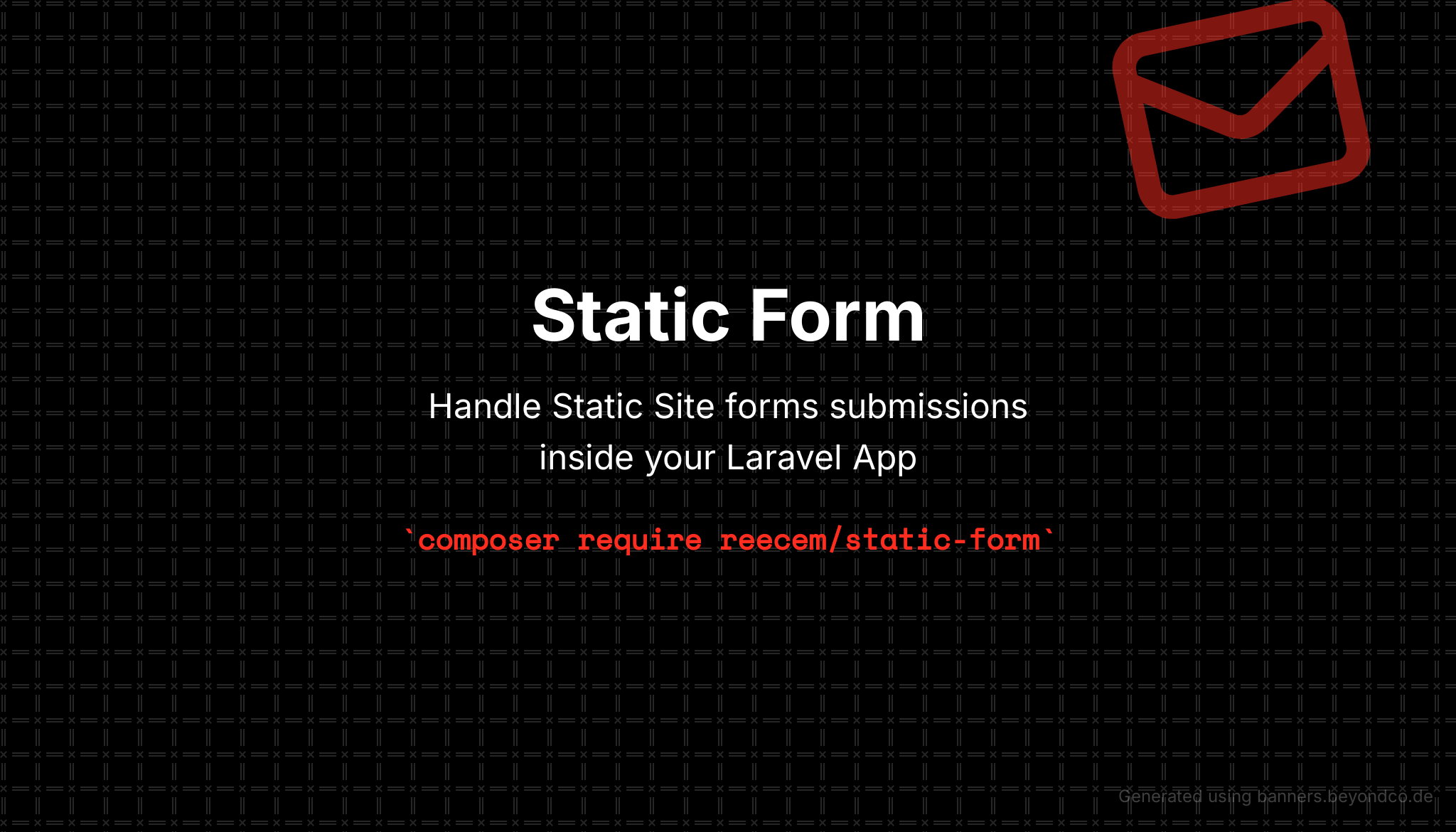Handle Static form submissions inside your Laravel app from Next.JS and Netlify or any other static site server.
You can install the package via composer:
composer require reecem/static-formTo install the application you can do the following:
php artisan static-form:install --provider --configThis will install the config file and the service provider, you can though opt for each one separately or use the following:
You can publish the config file with:
php artisan vendor:publish --provider="ReeceM\StaticForm\StaticFormServiceProvider" --tag="static-form-config"You can publish the Service Provider file with:
php artisan vendor:publish --provider="ReeceM\StaticForm\StaticFormServiceProvider" --tag="static-form-provider"You will need to add the following to the config/app.php file:
/*
* Package Service Providers...
*/
+ App\Providers\StaticFormServiceProvider::classYou can view the docs here https://static-form.pkgpg.dev
As an overview, the usage of the current version is that you can use the packages middleware on controllers that you define, this will then use your controller to handle the request data.
The first step is to generate your token, to do that you can use the console command:
php artisan static-form --refreshThis will generate your token, it will show you the plain text version only during that session.
The other way is to call the API endpoint to generate a new one. The API is secured via the Gate that is defined in the App\Providers\StaticFormServiceProvider::class
You can define any logic in there that would allow only authorized people to access the application.
To call the API endpoint, for now you can make a request to the endpoint through a custom UI and javascript code.
| Method | Endpoint | Description |
|---|---|---|
| GET | domain.tld/api/static-form/token | This will return a 200 status and the static-form package version if the toke is found |
| POST | PATCH | domain.tld/api/static-form/token |
The url part that says static-form can be changed and comes from the config key static-form.path
The response for creating a token would be the following JSON with a 201 status:
{
"plain_token": "random_string_that_is_40_characters_long",
"message": "Token Created, please keep this as it is available once"
}- Make a plugin UI, just deciding on if it should be in package or a separate snippet.
To use the middleware, you can define a route using the config file, I do suggest that you use the API endpoint, this is as it is stateless and also would not require the CSRF token.
// routes/api.php
Route::group([
'middleware' => config('static-form.middleware.forms'),
], function () {
// A controller that you have created.
Route::post('/contact', StaticContactController::class)->name('contact.create');
});On your static site, you can have your contact form. The way of handling the form is done using the API part of the hosting provider.
So for Vercel apps, you can create a new file under the api directory.
For the API part of the code:
// api/contactus.js
/**
* Create a contact request to the main server.
*
* @param {http.IncomingMessage} req
* @param {*} res
*/
import { APP_TOKEN, APP_URL } from "../../../lib/constants"
export default async function contactus(req, res) {
if (req.method !== 'POST') {
return res.status(400);
}
if (req.body?.website) {
return res.status(200);
}
let body = JSON.parse(req.body)
let {_token, xsrf} = body.token;
delete body.token
const request = await fetch(
`${APP_URL}/api/static-form/contactus`,
{
method: 'POST',
body: JSON.stringify(body),
headers: {
'X-STATIC-FORM': APP_TOKEN,
'Content-Type': 'application/json',
'Accept': 'application/json',
"x-requested-with": "XMLHttpRequest",
},
}
)
if (request.status !== 201 ) {
let json = await request.json()
throw new Error(json.message || 'Failed to fetch API');
}
const json = await request.json()
if (json.errors) {
console.error(json.errors)
throw new Error('Failed to fetch API, json errors')
}
return res.status(201).json(json.data ?? {});
}You can try a simple form layout for the frontend:
import React, { useCallback, useEffect, useRef, useState } from 'react'
const ContactUs = () => {
const [contactName, setContactName] = useState('')
const [contactEmail, setContactEmail] = useState('')
const [honey, setHoney] = useState('')
function handleForm(e) {
e.preventDefault()
if (honey.length >= 1) {
return
}
let body = {
name: contactName,
email: contactEmail,
}
fetch(
`${location.origin}/api/contactus`,
{
method: 'POST',
body: JSON.stringify(body)
}
)
.then(response => {
console.debug(response);
})
.catch(error => {
console.error(error)
})
}
return (
<>
<form onSubmit={handleForm}>
<div style={{marginBottom: '0.75rem'}}>
<label htmlFor="name">Name</label>
<input
name="name"
id="name"
value={contactName}
onChange={e => setContactName(e.target.value)}
placeholder="Your Name"
type="text"
/>
</div>
<div style={{marginBottom: '0.75rem'}}>
<label htmlFor="email">Email</label>
<input
name="email"
id="email"
value={contactEmail}
onChange={e => setContactEmail(e.target.value)}
placeholder="Your email"
type="email"
/>
</div>
<input style={{display: 'none'}} name="website" value={honey} onChange={e => setHoney(e.target.value)}> <!-- The honeypot field -->
<button type="submit">Submit</button>
</form>
</>
)
}
export default ContactUs;Testing is currently a work in progress, there are some :), I am manually testing it in an actual application to make sure it works though.
composer testPlease see CHANGELOG for more information on what has changed recently.
Please see CONTRIBUTING for details.
Please review our security policy on how to report security vulnerabilities.
The MIT License (MIT). Please see License File for more information.


